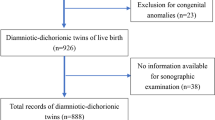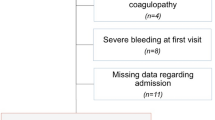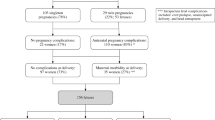Abstract
Objective:
To compare the perinatal outcome of quadruplets in relation to chorionicity.
Patients and methods:
In this retrospective study, the maternal, neonatal and chorionicity data were collected from 24 sets of quadruplet pregnancies delivered between January 1985 and December 2001. Perinatal and neonatal data were evaluated in relation to chorionicity.
Results:
Sixteen pregnancies were quadra-chorionic quadramniotic (QC) and eight had at least one monochorionic pair (TC). The median gestational age at delivery was 31 weeks (23 to 34 weeks) with overall perinatal mortality rate of 177 per 1000 total birth. Delivery before 30 weeks (OR 89; 95% CI 9 to 607; P<0.01) and discordant birth weight of >25% (OR 7.6; 95% CI 2 to 29; P<0.01) had independent effects on perinatal loss rate. The perinatal loss was five fold higher in TC quadruplets than those of QC (OR 5.1; 95% CI 1.7 to 15.4; P<0.001). This was attributed to higher risk of very low birth weight (69 vs 13%; P<0.01), delivery before 30 weeks (63 vs 13%; P<0.001) in TC quadruplets compared to QC gestation.
Conclusions:
The quadruplets with MC pair have 5 times higher perinatal mortality than quadra-chorionic quadruplet pregnancies owing to preterm delivery and discordant birth weight.
This is a preview of subscription content, access via your institution
Access options
Subscribe to this journal
Receive 12 print issues and online access
$259.00 per year
only $21.58 per issue
Buy this article
- Purchase on Springer Link
- Instant access to full article PDF
Prices may be subject to local taxes which are calculated during checkout
Similar content being viewed by others
References
Engmann L, Maconochie N, Tan SL, Bekir J . Trends in the incidence of births and multiple births and the factors that determine the probability of multiple birth after IVF treatment. Hum Reprod 2001; 16: 2598–2605.
Bajoria R, Kingdom J . The case for routine determination of chorionicity and zygosity in multiple pregnancy. Prenat Diagn 1997; 17: 1207–1225.
Sebire NJ, Snijders RJ, Hughes K, Sepulveda W, Nicolaides KH . The hidden mortality of monochorionic twin pregnancies. Br J Obstet Gynaecol 1997; 104: 1203–1207.
Adegbite AL, Ward SB, Bajoria R . Perinatal outcome of spontaneously conceived triplet pregnancies in relation to chorionicity. Am J Obstet Gynecol 2005; 193: 1463–1471.
Salihu HM, Aliyu MH, Kirby RS, Alexander GR . Effect of advanced maternal age on early mortality among quadruplets and quintuplets. Am J Obstet Gynecol 2004; 190: 383–388.
Pons JC, Nekhlyudov L, Dephot N, Le Moal S, Papiernik E . Management and outcomes of 65 quadruplet pregnancies: sixteen years’ experience in France. Acta Genet Med Gemellol (Roma) 1996; 45: 367–375.
Skrablin S, Kuvacic I, Pavicic D, Kalafatic D, Goluza T . Maternal neonatal outcome in quadruplet and quintuplet versus triplet gestations. Eur J Obstet Gynecol Reprod Biol 2000; 88: 147–152.
Strauss A, Paek BW, Genzel-Boroviczeny O, Schulze A, Janssen U, Hepp H . Multifetal gestation – maternal and perinatal outcome of 112 pregnancies. Fetal Diagn Ther 2002; 17: 209–217.
Wehbe SA, Tucker MJ, Palermo GD, Sills ES . Monozygotic twin delivery following reduction from quadramniotic-dichorionic gestation established after ICSI and embryo transfer: case report. Hum Reprod 2003; 18: 444–446.
Biljan MM, Hewitt J, Kingsland CR, Taylor CT . Trizygotic quadruplet pregnancy following in-vitro fertilization: an additional factor against replacement of three embryos in young patients? Hum Reprod 1995; 10: 2169–2170.
Bajoria R, Ward SB, Adegbite AL . Comparative study of perinatal outcome of dichorionic and trichorionic iatrogenic triplets. Am J Obstet Gynecol 2006; 194: 415–424.
Steinman G . Spontaneous monozygotic quadruplet pregnancy: an obstetric rarity. Obstet Gynecol 1998; 91: 866.
Timor-Tritsch IE, Fleischer A, Monteagudo A, Valderrama E . Monochorionic quadramniotic quadruplets: sonographic workup. Fetal Diagn Ther 1997; 12: 363–367.
Chow JS, Benson CB, Racowsky C, Doubilet PM, Ginsburg E . Frequency of a monochorionic pair in multiple gestations: relationship to mode of conception. J Ultrasound Med 2001; 20: 757–760.
De Catte L, Camus M, Foulon W . Monochorionic high-order multiple pregnancies and multifetal pregnancy reduction. Obstet Gynecol 2002; 100: 561–566.
Monteagudo A, Timor-Tritsch IE, Sharma S . Early and simple determination of chorionic and amniotic type in multifetal gestations in the first fourteen weeks by high-frequency transvaginal ultrasonography. Am J Obstet Gynecol 1994; 170: 824–829.
Sills ES, Tucker MJ, Palermo GD . Assisted reproductive technologies and monozygous twins: implications for future study and clinical practice. Twin Res 2000; 3: 217–223.
Milki AA, Jun SH, Hinckley MD, Behr B, Giudice LC, Westphal LM . Incidence of monozygotic twinning with blastocyst transfer compared to cleavage-stage transfer. Fertil Steril 200; 79: 503–506.
Collins MS, Bleyl JA . Seventy-one quadruplet pregnancies: management and outcome. Am J Obstet Gynecol 1990; 162: 1384–1391.
Elliott JP, Radin TG . Quadruplet pregnancy: contemporary management and outcome. Obstet Gynecol 1992; 80: 421–424.
Berg C, Baschat AA, Geipel A, Germer U, Smrcek J, Krapp M, Gembruch U . First trimester twin-to-twin transfusion syndrome in a trichorionic quadruplet pregnancy – a diagnostic challenge. Fetal Diagn Ther 2002; 17: 357–361.
Bajoria R, Wee LY, Anwar S, Ward S . Outcome of twin pregnancies complicated by single intrauterine death in relation to vascular anatomy of the monochorionic placenta. Hum Reprod 1999; 14: 2124–2130.
Bajoria R . Vascular anatomy of monochorionic placenta in relation to discordant growth and amniotic fluid volume. Hum Reprod 1998; 13: 2933–2940.
Matijevic R, Ward S, Bajoria R . Non-invasive method of evaluation of trophoblast invasion of spiral arteries in monochorionic twins with discordant birthweight. Placenta 2002; 23: 93–99.
Redline RW, Shah D, Sakar H, Schluchter M, Salvator A . Placental lesions associated with abnormal growth in twins. Pediatr Dev Pathol 2001; 4: 473–481.
Sato Y, Benirschke K . Increased prevalence of fetal thrombi in monochorionic-twin placentas. Pediatrics 2006; 117: e113–117.
Bajoria R, Sooranna SR, Ward S, D’Souza S, Hancock M . Placental transport rather than maternal concentration of amino acids regulates fetal growth in monochorionic twins: implications for fetal origin hypothesis. Am J Obstet Gynecol 2001; 185: 1239–1246.
Westwood M, Gibson JM, Sooranna SR, Ward S, Neilson JP, Bajoria R . Genes or placenta as modulator of fetal growth: evidence from the insulin-like growth factor axis in twins with discordant growth. Mol Hum Reprod 2001; 7: 387–395.
Adegbite AL, Castille S, Ward S, Bajoria R . Neuromorbidity in preterm twins in relation to chorionicity and discordant birth weight. Am J Obstet Gynecol 2004; 190: 156–163.
Author information
Authors and Affiliations
Corresponding author
Rights and permissions
About this article
Cite this article
Adegbite, A., Ward, B. & Bajoria, R. Perinatal outcome of quadruplet pregnancies in relation to chorionicity. J Perinatol 27, 15–21 (2007). https://doi.org/10.1038/sj.jp.7211632
Received:
Revised:
Accepted:
Published:
Issue Date:
DOI: https://doi.org/10.1038/sj.jp.7211632
Keywords
This article is cited by
-
Expectant management versus multifetal pregnancy reduction in higher order multiple pregnancies containing a monochorionic pair and a review of the literature
Archives of Gynecology and Obstetrics (2016)
-
Maternal and neonatal outcome in triplet, quadruplet and quintuplet gestations following ART: a 11-year study
Archives of Gynecology and Obstetrics (2013)



